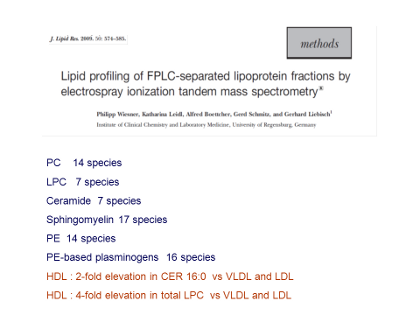Chapman - Figure 12 - Lipoprotein fractions Text
The Lipidome
All of the preceding information has concerned the lipoprotein structure of the HDL particles, ie, the proteome. The other major component of HDL particles that must be accounted for in understanding the metabolism and functions of HDL is the lipid component, the contents of the particles, ie, the lipidome.
Just as HDL particles form a spectrum, based on their proteomic structures, HDL particles can also be sorted into an array based on their variable lipid contents. For example, the largest, HDL2 particles contain about 50-60% lipid, whereas the smallest, most protein-dense HDL3 particles contain only about 20-30% lipid.
Using mass spectrometric techniques to analyze the lipid contents of the different HDL particles, the initial studies identified about 50 different lipids, including sphingomyelin, phosphatidylcholines, lysophosphatidylcholines, phosphatidylethanolamines, etc.
It is really only possible to discuss a selection of these lipids here, and one of the earliest to be identified, by Gerd Schmitz,[10] is a degradation product of sphingomyelin called ceramide. The interesting finding by Prof Schmitz was that there was a preferential transport of certain forms of ceramide in HDL. The reason that this is interesting is because ceramide is a cytotoxic lipid, and so its transported accumulation into HDL particles may represent a protective function of that particle. Already then, even at a very superficial level, this result showed that there might be a specialized lipid moiety, or lipidome, that characterizes HDL.
J Clin Lipidol. 2011; 5(6).References
[10]Wiesner P, Leidl K, Boettcher A, et al. Lipid profiling of FPLC-separated lipoprotein fractions byelectrospray ionization tandem mass spectrometry. J Lipid Res 2009;50:574- 585.
